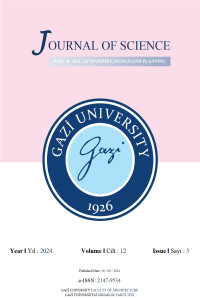Abstract
References
- [1] Lefebvre, H. (2014). Mekânın Üretimi. (Çev. Işık Ergüden). İstanbul: Sel Yayıncılık.
- [2] Cengizkan, A. (2004). Ankara’nın İlk Planı. (2. Baskı). Ankara: Arkadaş Yayınevi.
- [3] Kökalan Çımrın, F. (2010). Yeni Toplumsal Hareketler ve Kentsel Yaşam. Gümüşhane Üniversitesi Sosyal Bilimler Elektronik Dergisi 2, 46-58.
- [4] Tilly, C. (2008) Toplumsal Hareketler 1768-2004. (Çev. O. Düz). İstanbul: Babil Yayınları.
- [5] Giddens, A. (2000). Elimizden Kaçıp Giden Dünya. İstanbul: Alfa Basım Yayınları.
- [6] Tarrow, S. (1994). Power in Movement: Social Movements And Contentious Politics. Cambridge University Press.
- [7] Melucci A.(1999). Çağdaş Hareketlerin Sembolik Meydan Okuması, Yeni Sosyal Hareketler-Teorik Açılımlar. İstanbul: Kaknüs Yayınları.
- [8] Asrak Hasdemir, T. ve Coşkun, M. K. (2008). Kamusal Alan ve Toplumsal Hareketler. Ankara Üniversitesi SBF Dergisi, 63 (1), 122-149.
- [9] Zengin Çelik, D. (2019). Kent Mekânının Politik Bir Meta Olarak Keşfi. Gösteriler ve Karşı-Gösteriler. Galatasaray Üniversitesi İletişim Dergisi 4. 77-92.
- [10] Sahil, S. (1990). Başkent Ankara’daki Devlet Yapılarının Kentsel Mekânın Oluşma Sürecindeki Yeri. Gazi Üniversitesi Mühendislik-Mimarlık Fakültesi Dergisi, 5(1-2), 65-80.
The Impact of Social Movements on The Spatial Configuration of Urban Squares: Kızılay Square From 1950s To Today
Abstract
City squares have been the scene of various political, social events and have assumed political functions. The political ideology, forms the basis of spatial formation and the social opposition to it have necessitated the transformation of urban spaces. The dialectical relationship between space- social movements has been decisive in the transformation squares into spaces of representation. In Ankara, Kızılay Square’s the place where social movements are most intensely realized. This study aims to analyze the spatial transformation of Kızılay Square from 1950 to the present on the basis of social movements. In this study, the Republican Period is divided into three sub-sections: 1950-1980, 1980-2000, after 2000. Breakpoints in political economy decisions and urban policies were taken into consideration in the subdivisions. For each period, the spatial formation of Kızılay Square and the social movements in Kızılay Square were presented, then the data obtained for each of the three periods were compared. spatial analysis of Kızılay Square, planning and construction data, visuals, and digital aerial photographs of Kızılay and its surroundings obtained by the General Directorate of Mapping of the Ministry of National Defense the Republic of Turkey were used. From the 1950s to the present day, Kızılay Square has increasingly lost its cultural, bureaucratic, political and social functions and the space has been fragmented and detached from its gathering function. As a result of this transformation, Kızılay Square has been reproduced with changing ideologies, eroding its place in the social memory as well as its position in the urban memory.
References
- [1] Lefebvre, H. (2014). Mekânın Üretimi. (Çev. Işık Ergüden). İstanbul: Sel Yayıncılık.
- [2] Cengizkan, A. (2004). Ankara’nın İlk Planı. (2. Baskı). Ankara: Arkadaş Yayınevi.
- [3] Kökalan Çımrın, F. (2010). Yeni Toplumsal Hareketler ve Kentsel Yaşam. Gümüşhane Üniversitesi Sosyal Bilimler Elektronik Dergisi 2, 46-58.
- [4] Tilly, C. (2008) Toplumsal Hareketler 1768-2004. (Çev. O. Düz). İstanbul: Babil Yayınları.
- [5] Giddens, A. (2000). Elimizden Kaçıp Giden Dünya. İstanbul: Alfa Basım Yayınları.
- [6] Tarrow, S. (1994). Power in Movement: Social Movements And Contentious Politics. Cambridge University Press.
- [7] Melucci A.(1999). Çağdaş Hareketlerin Sembolik Meydan Okuması, Yeni Sosyal Hareketler-Teorik Açılımlar. İstanbul: Kaknüs Yayınları.
- [8] Asrak Hasdemir, T. ve Coşkun, M. K. (2008). Kamusal Alan ve Toplumsal Hareketler. Ankara Üniversitesi SBF Dergisi, 63 (1), 122-149.
- [9] Zengin Çelik, D. (2019). Kent Mekânının Politik Bir Meta Olarak Keşfi. Gösteriler ve Karşı-Gösteriler. Galatasaray Üniversitesi İletişim Dergisi 4. 77-92.
- [10] Sahil, S. (1990). Başkent Ankara’daki Devlet Yapılarının Kentsel Mekânın Oluşma Sürecindeki Yeri. Gazi Üniversitesi Mühendislik-Mimarlık Fakültesi Dergisi, 5(1-2), 65-80.
Details
| Primary Language | English |
|---|---|
| Subjects | Architectural Design |
| Journal Section | Architecture |
| Authors | |
| Publication Date | September 30, 2024 |
| Submission Date | May 6, 2024 |
| Acceptance Date | September 27, 2024 |
| Published in Issue | Year 2024 Volume: 12 Issue: 3 |


